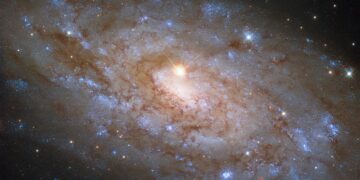In the vast and ever-expanding cosmos, some of the most stunning visuals come not from grand explosions or cosmic collisions—but from a well-timed line of sight. That’s exactly what the Hubble Space Telescope captured in its latest image of the flocculent spiral galaxy NGC 5530, located 40 million light-years away in the constellation Lupus.
The Beauty of Flocculent Spirals: Patchwork Perfection in Space
NGC 5530 isn’t your typical spiral galaxy. While galaxies like the Whirlpool Galaxy or Andromeda boast clean, majestic spiral arms, NGC 5530 is a “flocculent spiral galaxy,” a type that displays patchy, wool-like structures rather than defined arms. These galaxies might seem messy at first glance, but in reality, they offer valuable insights into the chaotic and ongoing processes of star formation.
According to the European Space Agency (ESA), flocculent spirals represent a less orderly—but no less dynamic—style of galactic evolution. Their arms form from local bursts of star formation triggered by density waves or interstellar turbulence, rather than large-scale spiral density waves. This distinction gives astronomers clues about how stars are born and distributed in different galactic environments.
A Star in the Way: The Magic of Chance Alignment
One of the most visually confusing and scientifically interesting aspects of the image is the bright star seemingly sitting in the heart of NGC 5530. But this star isn’t part of the distant galaxy—it’s a foreground object in our own Milky Way. Thanks to the angle at which Earth, the star, and NGC 5530 are aligned, this nearby star creates the illusion that it belongs to the faraway galaxy.
This “chance alignment” is a powerful reminder of how astronomical perspective can influence our observations. It’s also a fantastic teaching moment, showing how stars and galaxies at vastly different distances can appear superimposed in telescope images. ESA’s official statement clarifies this beautifully: while the light may be deceiving, careful measurements—like parallax and redshift—tell the true story of how far apart these objects really are.
The Supernova That Stole the Spotlight: SN 2007IT
NGC 5530 has another claim to fame beyond its unusual structure and optical illusions—it was also the host galaxy of a spectacular supernova, SN 2007IT. This explosive event was discovered not by a space observatory, but by an amateur astronomer named Robert Evans—a true legend in the world of stargazing.
On September 13, 2007, Evans noticed a new point of light in NGC 5530 by manually comparing telescope images with archived reference photos. This method, while slow and labor-intensive, has yielded extraordinary results: Evans has discovered over 40 supernovae using this technique, more than almost any other individual in history.
What’s even more remarkable is the timing. The light from SN 2007IT had been traveling for 40 million years, and Evans spotted it just days after it arrived. His find underscores the value of amateur contributions to astronomy, even in an era of space-based observatories and AI-driven sky surveys.
Unraveling the Science: What We Learn from NGC 5530
So why does this galaxy—and its coincidental alignment—matter so much?
First, NGC 5530 offers a living laboratory for studying flocculent spiral structure and localized star formation. While grand-design spirals follow predictable patterns, galaxies like this one tell us more about decentralized, spontaneous processes in the universe.
Second, the chance alignment with a nearby star highlights the importance of perspective and measurement tools in astrophysics. Without redshift data or parallax methods, we could mistakenly assume the star and galaxy are connected. This mistake could lead to false conclusions about the dynamics or brightness of celestial bodies.
Third, the discovery of SN 2007IT in NGC 5530 provides astronomers with data on stellar death and galactic chemical enrichment. Supernovae distribute heavy elements—like iron and gold—into surrounding space, seeding future generations of stars and planets.
Finally, this story reaffirms the human element of astronomy. From Hubble’s advanced optics to Evans’ careful eye, the tale of NGC 5530 is a testament to how technology and curiosity work hand-in-hand to unlock the cosmos.
Why It Matters: Public Engagement and Cosmic Wonder
Astronomy isn’t just for scientists. Stories like this capture public imagination and make the universe feel a little closer to home. When people see the bright light in the center of NGC 5530, they naturally ask questions: “Is that a black hole? A star? Why does it look like that?” These questions open the door to science literacy, education, and wonder.
Moreover, NGC 5530’s case encourages amateur astronomers to keep looking up. As Robert Evans proved, you don’t need million-dollar equipment to make a discovery—just dedication and passion. With tools as accessible as backyard telescopes and sky charts, the next great find could belong to anyone.
Looking Ahead: What’s Next for NGC 5530 and Hubble
As of now, NGC 5530 continues to be monitored as part of broader Hubble campaigns aimed at studying galactic morphology and supernova remnants. Future observations using telescopes like the James Webb Space Telescope (JWST) may reveal even more about the star-forming regions within this flocculent spiral, helping astronomers map out its chemical composition, star populations, and core dynamics.
Meanwhile, ESA and NASA continue to release weekly “Picture of the Week” features to engage the public and showcase the universe’s breathtaking diversity. The story of NGC 5530 is just one of many—yet it stands out for its blend of scientific significance and visual intrigue.
Conclusion: One Galaxy, Many Stories
NGC 5530 is more than just a pretty picture. It’s a cosmic classroom, a detective story, and a celebration of human curiosity all rolled into one. From its flocculent arms and chance alignment to its hidden supernova and amateur-powered discovery, this distant galaxy offers lessons in perspective, perseverance, and the power of observation.



















